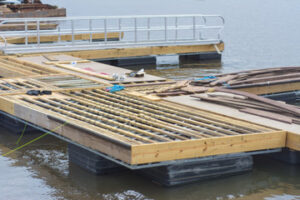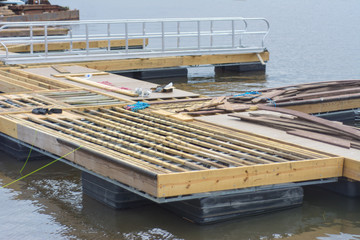Dock construction focuses on building structures for use in and around water. This may involve anything from piers to wharves to floating docks.
Many people choose to construct their docks as a way of cutting costs. The best docks are made from quality materials and built to withstand the elements. Click here to Learn More.

The material a dock is made from carries the full load of the structure and should be chosen carefully to ensure its stability. Most docks are built on pilings, which transfer the structure’s weight to layers of earth and rock beneath it. This means that the choice of piles is crucial, as they will be subject to various stresses from stormy weather to day-to-day use.
Although traditionally made from natural wood, this isn’t the only material available for docks. Man-made materials like fiberglass offer a number of benefits over traditional wooden planking, such as the fact that they are resistant to rot, insect infestation and rust. Additionally, they don’t require staining or splinters and can withstand the Florida sun much more effectively than natural wood.
Concrete is another common option, as it’s often used for piers and jettys on commercial docks and marinas. It’s also durable and resistant to the impact of water, and unlike some other options it won’t degrade in a way that affects the quality of the surrounding waters.
Another alternative is to use aluminum, which is extremely lightweight but still offers excellent strength in relation to its weight. It’s not uncommon for marine contractors to use it on larger, heavy-load docks. It can even be used in conjunction with composites to create a more structurally sound dock.
Finally, some people choose to build their docks from a synthetic or plastic material. While these tend to cost more upfront than their natural or wood counterparts, they also don’t rot, rust or attract insects. They are also a great choice for those concerned about environmental sustainability, as they can be easily recycled at the end of their lifespan.
The most durable and stable docks are usually built from metals, such as steel, that can withstand a huge amount of pressure. They are often fastened using blind bolts, which allows them to be installed from a single side, minimizing the risk to workers who might otherwise face exposure during construction. They’re typically suited to commercial or marine docks that are expected to experience high levels of traffic and wear.
Whether a dock is made of wood or composite it will need to have the right design for the specific conditions where it will be built. Choosing the proper size dock for the property will help to ensure that it will accommodate watercrafts of all sizes and that it will be safe and convenient for boaters. A dock will also need to be able to cope with the effects of weather, waves and tidal currents. It is important to plan ahead when designing a dock to safeguard against future remodeling costs. This can be done by including knock out panels for future door expansions or using wheel risers to make it easier for smaller trucks to get up onto the dock. These small steps can save your customer money and time in the long run.
Choosing the right decking material for the dock is an important decision as well. While the de facto standard for a wood dock is Southern Yellow Pine it is not as durable or attractive as other options such as Ipe or tropical hardwoods. Depending on the environmental conditions and use of the dock it may be necessary to choose something more durable such as concrete.
It is always important to keep in mind that the laws of a particular jurisdiction may affect dock construction. In some areas permits are required and in others there are restrictions on the kinds of docks that can be constructed. It is also a good idea to check with local officials about whether any special planning or permit procedures are required for the location where the dock will be built.
In many cases it may be possible to find a dock designer that will incorporate the products and building process used by the company doing the dock installation. This will provide accurate visual representation and real-time estimates for the customer. This will shorten sales cycles and reduce the need for rework and revisions to the dock design.
Choosing the correct dock design for a particular location can be very difficult because different environments have their own unique demands. A floating dock for example would not work in an area that is prone to harsh winters and ice build-up because it won’t be able to remain stable. A fixed dock, on the other hand, can be anchored to the bottom of the lake or river bed making it less susceptible to changes in water level.
A dock is a structure built out into the water that enables vessels to berth. It can be constructed either on the shore or in open waters, depending on the nature of the property and the intended use of the dock. Some docks are used for commercial and industrial purposes, while others serve private waterfront owners. They can be constructed in lakes, rivers, ponds and the ocean, and can be freestanding or attached to the shore by a gangway.
Dock construction can be complex. Whether they are constructed of concrete or wood, these structures have to be able to resist high winds and other environmental factors, such as tidal currents and waves. They must also be able to accommodate the weight of the vessels that are berthed on them.
Depending on the location of the dock, water conditions and beach hazards or obstructions will influence its design. For example, if the dock is to be located on a sandy beach, it must be built with a strong base that can stand up to high tides and shifting water levels.
To avoid costly repairs, it is best to build a pier from a material that will not deteriorate in contact with water. The most common choice is concrete, but some people prefer to use wood, especially if it has been treated to resist the effects of the water. However, wooden pilings are vulnerable to rot, which can be a major issue for dock construction.
The first step in dock construction is to prepare the site of the pier. This involves clearing the area and laying a foundation of concrete or stones. The concrete foundation needs to be a minimum of four feet thick, and it should also be reinforced with steel bars. The next step is to install the decking of the pier, and it should be spaced evenly across the length of the dock. The decking is typically made of wood, but it can also be made of composite or concrete.
Once the decking has been installed, it is time to start assembling the rest of the dock. It is a good idea to assemble as much of the dock on land as possible, since this will make it easier to transport and set in place. For example, it is easier to handle brackets and posts when they are not in the water. It is also easier to level the components while they are still on land.
If you own a dock, it will need regular maintenance. Wood is susceptible to discoloration and deterioration over time, particularly when exposed to sunlight and water. It is best to inspect your dock on a regular basis and fix any damage as soon as it occurs to avoid costly repairs and replacements in the future. A small problem like a rotting board or nail that sticks out is a simple repair, but if the foundation of your dock is starting to degrade, it may be time for a complete replacement.
Inspect the wood sections of your dock for rot and decay, and splinters. It is important to regularly clean your dock and apply a waterproof sealant. It is recommended that you use a low volatile organic compound (VOC) sealant to minimize the environmental impact.
The most common type of waterfront structure is a dock, which can be categorized as either a quay wall, wharf, or pier. Quay walls are a retaining wall along the shore topped with a deck or platform that serve as a terminal for boats and cargo ships to load and unload passengers, freight, or fuel. Wharves are elongated structures that extend into the sea or lake for the purpose of loading and unloading vessels and equipment, and can be constructed in many sizes, styles, and materials.
Docks can also be used as a jumping off point for boats and other recreational watercrafts. They can be built from a variety of materials, including concrete, steel, and wood. In addition, docks can be equipped with a variety of amenities, such as shade structures, fishing platforms, and boat lifts.
A pile driver is a member of the maritime construction industry that installs pilings for docks, bridges, and tunnels, using hydraulic cranes to lift heavy timbers into place. Another member of this field is a dock builder, who may oversee the construction and installation of these water-based facilities.
Both pile drivers and dock builders receive classroom and hands-on training from state-of-the-art technical schools. They learn to operate and maintain a wide range of equipment and tools for marine construction. They are also trained to perform inspections of various kinds.
